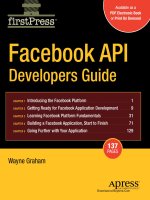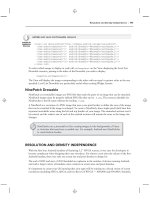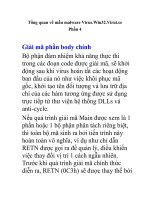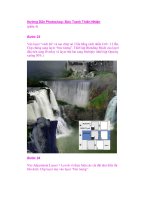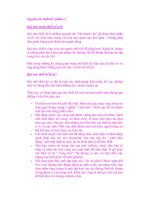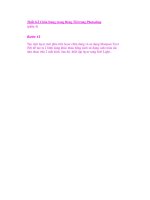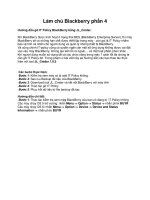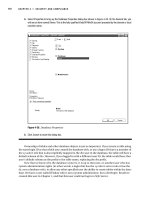Facebook API Developers Guide PHẦN 4 ppsx
Bạn đang xem bản rút gọn của tài liệu. Xem và tải ngay bản đầy đủ của tài liệu tại đây (646.47 KB, 15 trang )
Learning Facebook Platform Fundamentals 33
Graham
pear install PhpDocumentor
PEAR should install a new script that you can call from the command-line script, which
you then can call to create the documentation:
phpdoc -t /path/to/output -d /path/to/facebook_client_library -pp on –ti Facebook
Client Documentation
This line will set the output directory (-t), take a look at the client library path (-d),
parse private functions within the code (-pp), set an HTML title of “Facebook Client
Documentation” (-ti), and then output the results in HTML using frames. There are many
more options for producing documentation, but these options will produce very useful
documentation while you develop your Facebook application. For more information about
using this tool, check out the phpDocumentor web site at />API Primer
Facebook has some rather convenient out-of-the box tools for interacting with its back end.
At the core of the platform is a set of API calls that wrap more complex code into a single
call. In fact, most of the API calls are simply wrappers for complex FQL calls. So, without
further adieu, let’s take a look at what you have available to you through the API calls.
Facebook’s API methods are broken into logical groups of calls. These API calls are
also where your first interaction with the platform comes into play. You don’t need to use
the client library—it just makes things faster since you would need to write these in your
language in order to interact with the platform.
To set up the client library for PHP, you simply include the client library in your code.
For example, the following snippet makes sure users are logged on to Facebook before
displaying a list of the user’s friends. Figure 3-1 shows the results.
<?php
/**
* Set the configuration settings for Facebook
*/
$facebook_config['debug'] = false;
$facebook_config['api_key'] = '<your_api_key>';
$facebook_config['secret_key'] = '<your_secret_key>';
/**
* include the Facebook client library
*/
require_once('<path_to_client_library>/facebook.php');
/**
34 Learning Facebook Platform Fundamentals
Graham
* Set up the facebook object
*/
$facebook = new Facebook($facebook_config['api_key'],
$facebook_config['secret']);
/**
* Ensure the user has logged on to Facebook
*/
$user = $facebook->require_login();
/**
* Make an API call to call get a user's friends using the PHP library's
* library
*/
$friends = $facebook->api_client->friends_get();
echo "<pre>Friends:" . print_r($friends, true). "</pre>";
?>
Figure 3-1. Results of friends_get API call
You’ll notice a few things in this example. First, you’re just throwing the results from
the friends object on the screen. I’ll cover interacting with the resulting code with FBML a
bit later. Second, the syntax for interacting with the API is abstracted into methods in the
Learning Facebook Platform Fundamentals 35
Graham
Facebook object. You first set up the Facebook object with the API and secret keys that
Facebook assigns to you when you set up your application.
You’ll also notice that you require the user to be logged on to Facebook in order to
execute the code. This example uses the require_login() method and stores the user’s
identification number (UID) in the variable user. The next call actually queries the
Facebook API method friends.get by wrapping it in the PHP method friends_get. Since
the facebook object holds the user’s identification number (their primary key or UID),
there’s no need to pass the UID to the API request. From this short sample code, you can
see that the PHP code is actually setting up a REST client to call the facebook.friends.get
API method and returns an array of user identifiers:
/**
* Returns the friends of the current session user.
* @return array of friends
*/
public function friends_get() {
if (isset($this->friends_list)) {
return $this->friends_list;
}
return $this->call_method('facebook.friends.get', array());
}
The client libraries allow you to concentrate on developing your application rather than
recoding your interactions with the platform. Since you need to know what you can do with
the API, let’s take a slightly closer look at the rest of the calls and what they do.
Authentication
The REST API has two methods for dealing with authenticating your users. The method
facebook.auth.createToken creates an authentication token (auth_token) that is then passed
to the Facebook authentication mechanism. After the user is logged in, the second REST
method, facebook.auth.getSession, will contain this token in the response, but only if you
specifically request the auth_token in the response.
Authentication is usually (at least when it’s done well) a big headache for developing
online applications. Because Facebook takes responsibility for these actions, you don’t have
to purchase SSL certifications, implement your own encryption schema for passwords, or
even worry about sessions. In the case of the PHP client library, you start the authentication
procedure by calling the Facebook object’s require_login method. By calling this method,
your users are redirected to Facebook’s login pages
( which are passed your API key, and the user is
given a session key and redirected to your callback page. The only difference is that when
36 Learning Facebook Platform Fundamentals
Graham
the user enters the application for the first time, they are asked to accept the terms of service
for the application.
Now, you might find yourself in need of performing some task (such as updating
FBML), but instead of logging into Facebook every time, you want to update the data to use
some sort of scheduled task. You are able to do this with an infinite session key.
The process to get your infinite key is a bit convoluted (but, hey, you have to do it only
once for each application). After creating your application, create a new page
(infinite_key.php) in your callback domain that creates a new Facebook object and echoes
your session_key:
<?php
/**
* @title infinite_key.php
*/
$facebook_config['debug'] = false;
$facebook_config['api_key'] = '<your_api_key>';
$facebook_config['secret_key'] = '<your_secret_key>';
require_once('<path_to_api>/facebook.php');
$facebook = new Facebook($facebook_config['api_key'],
$facebook_config['secret']);
// force a login page
$user = $facebook->require_login();
$infinate_key = $facebook->api_client->session_key;
echo($infinate_key);
?>
Once you have this code on your server, log out of Facebook, clear your Facebook
cookies and browser cache (just to make sure nothing funky is going on), and then go to the
page you just created on your server (that is, not the application URL, but the actual URL).
You will be asked to log on again, so do so, but make sure you check the No Longer Have
to Log In to Facebook box. After you’ve logged on, you should see the infinite key that you
can then use in your code.
You can now use your own UID and key in other code to perform anything that needs
to happen on a regular basis with the set_user function in the facebook object:
Learning Facebook Platform Fundamentals 37
Graham
<?php
$uid = '<your_uid>';
$key = '<your infinite key>';
$facebook->set_user($uid, $key);
// code that needs to be executed
?>
The infinite key is a powerful construct for your Facebook application that you might
find you need to implement. Most of the folks who have needed this are updating FBML for
features such as mini-feeds or pushing content to their user’s profile page.
Events
Event calls have two main wrappers to retrieve information on events. The first,
facebook.events.get, returns a response based on the filters passed to it. The second,
facebook.events.getMembers, returns the RSVP status for Facebook members for a given
event.
FBML
To deal with some of the more advanced features of FBML, Facebook has three API
methods to help you. The facebook.fbml.refreshImgSrc method fetches and caches an
image at a given URL. To refresh content from a given URL, you use the
facebook.fbml.refreshRefUrl method. Lastly, to use content as a handle in FBML, you can
call the facebook.fbml.setRefHandles method.
Feed
To update a user’s news feed, the REST API has two methods. To publish information to an
individual user’s feed, the facebook.feed.publishStoryToUser method will publish
information to a user’s feed based on their session key (session_key) and their user ID (uid).
You add the title, body, and various links, depending on what you want to publish. The
second method, facebook.feed.publishActionOfUser, publishes a mini-feed story to the
user’s account, also based on their session key and user ID.
38 Learning Facebook Platform Fundamentals
Graham
FQL
As I’ve mentioned, most of the calls in the REST API are wrappers for complex, but
common, FQL queries. The facebook.fql method takes a query and returns a response
object based on your syntax. In the Facebook documentation, most of the API requests have
their FQL equivalents, so if you see you need something slightly different from what is
provided in the API calls, check out the FQL equivalents before you start writing from
scratch.
Friends
When you’re developing applications, you might find it necessary to look at the friends of
your users. There are three methods provided to deal with this. The method
facebook.friends.areFriends will tell you whether two people are friends. The
facebook.friends.get method returns a structure of the user’s friends’ user IDs. Lastly, the
facebook.friends.getAppUsers method returns a structure of the friends of the user who
have installed the application on which you’re working.
Groups
If you want to work with your user’s groups, the REST API has two methods that return
information about their visible groups. When you call the facebook.groups.get method, you
can retrieve all the groups the user belongs to, or a subset of these groups, by using the
method’s filtering mechanism. The second method, facebook.groups.getMembers, returns the
user IDs (UIDs) for a given public group.
Marketplace
Facebook’s marketplace is a place to buy/sell items, list jobs, list housing, or even request
items to purchase/borrow through Facebook. You’re able to search the Facebook
marketplace with facebook.marketplace.search. There are getters and setters for listings
with facebook.marketplace.getListings and facebook.marketplace.createListing. You can
also remove listings with facebook.marketplace.removeListing. Facebook also has a
category and a subcategory getter method, facebook.marketplace.getCategories and
facebook.marketplace.getSubCategories.
Learning Facebook Platform Fundamentals 39
Graham
Notifications
Facebook allows you to send and receive notifications in your application with the REST
API. You can expose your user’s request notifications, by using the
facebook.notifications.get method, to see outstanding notification responses. You can
also send notifications to your users with the facebook.notifications.send method and send
invitations with the facebook.notifications.sendRequest method.
Photos
With more than 60 million images added each week by Facebook users, there are several
REST methods to interact with users’ images. You can tag images with the
facebook.photos.addTag method or create photo albums with the
facebook.photos.createAlbum method. You can get a user’s individual photos with the
facebook.photos.get method or a listing of their albums with the
facebook.photos.getAlbums method. You can also get the listing of the tags that individual
photos have with the facebook.photo.getTags method. I’ll cover the workflow of this later,
but you can also upload photos with the facebook.photos.upload method.
Profile
To easily interact with setting information in the user’s profile, there are two methods to
work with, facebook.profile.setFBML and facebook.profile.getFBML. I’ll cover the FBML a
bit later, but essentially these methods allow you to set and get FBML for a user’s profile
box and profile actions.
Users
The final set of methods in the REST API gives you access to some user information for
your application. The first, facebook.users.isAppAdded, tells you whether the user has added
your application. To get information from your user’s profile, you can call the method
facebook.users.getInfo. Lastly, to get the user ID (uid) from a session key, use the
facebook.users.getLoggedInUser method.
Error Codes
Sometimes when you’re developing an application, you make mistakes. Fortunately,
Facebook returns rather robust error messages when something goes wrong (like you forgot
40 Learning Facebook Platform Fundamentals
Graham
to provide a specific parameter for an API call). The error codes are returned with both a
numeric value and a message. Generally, if you receive an error message (in a structure),
it’s rather obvious when you read the error message (in the err_msg element). If you can’t
figure out what’s going on with a specific call, it’s always a good idea to check out the code
in the API Test Console ( Although this won’t
give you any more information than you are getting returned, it can help you narrow down
what’s going on (in case you have multiple errors).
Data Store API
Facebook also has implemented an API for basic database manipulations with its Data Store
API (which is still in beta as of this writing). This API provides a basic create, read, update,
and delete (CRUD) API for storing data that you access through REST. If you’re unfamiliar
with object-oriented database management systems (OODMSs), some of the terminology is
a bit different from that for relational database management systems (RDBMSs). For
instance, to use the Data Store API, you must define your schema (your database), which
consists of object types (tables) and properties (columns).
One of the really nice features of the Facebook Data Store API is that Facebook does
not plan to charge for normal use! You basically have use of Facebook’s servers to perform
your database manipulations for you. However, it’s probably not quite time to get rid of
your RDBMS yet, because there aren’t any structured queries, full-text search, or
transaction-level query processing in the Facebook Data Store API.
Note ➡ The Data Store API is still in beta as of the writing of this book. Because of this, there is a chance
that what I write here will change. Please consult the wiki documentation for the latest information before
you deploy any projects using the Data Store API.
The Data Store API consists of three basic functions: specialized tables, distributed
tables, and associations that are split into five separate APIs (User Preference, Object Data
Definition, Object Data Access, Association Data Definition, and Association Data Access).
Since Facebook provides access to millions of users, the tables (objects) you create are
distributed. Facebook does provide a specialized table of users that is optimized (if you find
that you really need more, let the Facebook developers know at their Bugzilla site,
The associations component of this API is a
mechanism to provide performance for fast lookups (such as indexes). Because indexing
tables in a distributed environment won’t necessarily provide a performance boost, this
Learning Facebook Platform Fundamentals 41
Graham
mechanism has been implemented to provide fast lookups without centralized indexes or
parallel queries.
The user preferences for the API consist of 128-character strings, for which you can
store up to 201 for each user (numbered 0–200). Access to the getters/setters are accessed
through getters and setters in the REST API (facebook.data.setUserPreference and
facebook.data.getUserPreferences).
Data objects (that is, tables) are created with facebook.createObjectType. The object
type takes a name and contains a set of object properties (that is, columns). Object
properties have names and data types. You don’t quite have the same type of control over
the data types with the API as you do with your own RDBMS because you are limited to
integers, strings (less than 256 characters), and text blobs (with a maximum of 64KB).
After defining your objects and object types, you create, read, update, and delete
through the Object Data Access API. These are rather straightforward
(facebook.data.createObject, and so on).
To work with the associations between objects, you first need to define the relationship
between objects in the facebook.defineAssociation call. You can define two types of
associations: one-way, symmetric associations and asymmetric associations. If you’re
familiar with RDBMS joins, think of an asymmetric association as a many-to-many join
and a symmetric association as a one-to-many join. One-way associations are an association
between objects that can happen only one way (in other words, there’s no need to look up a
value by some ID) for a given object. You then create the actual associations with the
Association Data Access API. These methods allow you to create, remove, and retrieve
these associations and retrieve the object details from the data contained in the data
definition.
This can be confusing at first, so let’s look at an example:
<?php
$createObject = $facebook->api_client->data_createObjectType("wallpost");
$uid = $facebook->api_client->data_defineObjectProperty("wallpost", "uid", 1);
$time = $facebook->api_client->data_defineObjectProperty("wallpost", "timePosted",
2);
$post = $facebook->api_client->data_defineObjectProperty("wallpost", "post", 3);
?>
The previous snippet of code is analogous to the following SQL DDL:
CREATE TABLE wallpost(
42 Learning Facebook Platform Fundamentals
Graham
uid integer,
timePosted timestamp,
post text
)
As you can see in this simple example, this can take a little bit to get used to because
you’re not performing your typical SQL DDL; however, once you get your mind around
how to create the objects, it’s relatively trivial to use the API as the persistence layer for
your application. I suspect that this API will eventually make it out of beta and be quite a
powerful tool in the Facebook developer’s toolbox, at least for those who choose to have
Facebook manage their data.
FQL Primer
If you’ve worked with SQL before (and I assume you have), FQL isn’t a big deal. You use
the same syntax as typical ANSI-SQL, and there are only nine tables to deal with. There
are, however, some important differences. There are no joins, and FQL has not
implemented the LIMIT, GROUP BY, or ORDER BY clauses that are common to ANSI
SQL–compliant implementations. Before we go any further, let’s take a look at the tables
and fields that are exposed to the Facebook Query Language.
Tables
Here’s a list to make sure you know what’s available to you in the different tables. (OK,
these aren’t really tables; more likely these are views of specific data, but for simplicity’s
sake, we’ll just call them tables.)
• users(uid, first_name, last_name, name*, pic_small, pic_big, pic_square, pic,
affiliations, profile_update_time, timezone, religion, birthday, sex,
hometown_location, meeting_sex, meeting_for, relationship_status,
significant_other_id, political, current_location, activities, interests,
is_app_user, music, tv, movies, books, quotes, about_me, hs_info,
education_history, work_history, notes_count, wall_count, status,
has_added_app)
• friend(uid1, uid2)
• group(gid, name, nid, pic_small, pic_big, pic, description, group_type,
group_subtype, recent_news, creator, update_time, office, website, venue)
• group_member(uid, gid, positions)
Learning Facebook Platform Fundamentals 43
Graham
• event(eid, name, tagline, nid, pic_small, pic_big, pic, host, description,
event_type, event_subtype, start_time, end_time, creator, update_time,
location, venue)
• event_member(uid, eid, rsvp_status)
• photo(pid, aid, owner, src_small, src_big, src, link, caption, created)
• album(aid, cover_pid, owner, name, created, modified, description, location,
size)
• photo_tag(pid, subject, xcoord, ycoord)
Functions and Operators
Although the FQL language isn’t ANSI-SQL complete, it does have some simple operators
and functions to help you work with user data. FQL has boolean operators (AND, OR, and
NOT), comparison operators (=, >, >=, <, <=, <>), and arithmetic operators (+, -, *, and /).
The functions included in FQL, although not exhaustive, allow you to perform some basic
string manipulations. To conserve bandwidth, you can use the concat() function to group
several tuples together:
<?php
$facebook_config['debug'] = false;
$facebook_config['api_key'] = '<your_api_key>';
$facebook_config['secret_key'] = '<your_secret_key>';
require_once('<path_to_client_library>/facebook.php');
$facebook = new Facebook($facebook_config['api_key'],
$facebook_config['secret']);
/**
* Ensure the user has logged on to Facebook
*/
$user = $facebook->require_login();
/**
* Construct the FQL request
*/
$fql = "SELECT concat(first_name, ' ', last_name)
2ca983ba3745582e6151dc1b079b2db0
44 Learning Facebook Platform Fundamentals
Graham
FROM user
WHERE uid = '$user'";
/**
* Pass the FQL to Facebook through the API client
*/
$fql_result = $facebook->api_client->fql_query($fql);
/**
* Print the results to the screen
*/
echo "<pre>FQL Result:" . print_r($fql_result, true) . "</pre>";
?>
The previous example simply selects the first and last names of the user who is
currently making the request. The resulting page will display an array in the following
format:
FQL Result:Array
(
[0] => Array
(
[anon] => <your_first_name> <your_last_name>
)
)
You might be saying to yourself, “This is pretty useless. What’s the difference between
this and just calling both the fields?” Well, if you have any bandwidth concerns, you can
alleviate some of those issues by using the concat function to put fields that you need
together. For instance, you might want to put a specific string into your page that combines
several fields in a specific way. Letting the Facebook servers do some of this processing
before it gets back to your server will not only decrease your server load but can also cut
down on your bandwidth in order to speed up your application.
Not only can you do simple SQL-style selects, but you can also perform subqueries.
Take, for example, this FQL equivalent for the facebook.events.get REST API call:
SELECT eid, name, tagline, nid, pic, pic_big, pic_small, host, description,
event_type, event_subtype, start_time, end_time, creator, update_time,
location, venue
FROM event
WHERE eid IN (SELECT eid FROM event_member
WHERE uid=uid AND rsvp_status=rsvp_status) AND
eid IN (eids) AND
Learning Facebook Platform Fundamentals 45
Graham
end_time >= start_time AND
start_time < end_time
I won’t go into the theory behind nested queries, but I will mention that they are very
useful for testing set membership, set comparisons, and set cardinality. And, this expansion
of the REST call serves as a good example for writing your own custom FQL expressions.
You might find that you will need to take some additional processing to make sure your
information is displayed in a specific order. You’ll have to do this with your client
language. For PHP, you need to sort the array and then slice it. Let’s take the following:
<?php
$fql = "SELECT eid, name, location
FROM event
WHERE eid IN (
SELECT eid
FROM event_member
WHERE uid = '$user'
)";
$fql_result = $facebook->api_client->fql_query($fql);
asort($fql_result);
array_slice($fql_result, 0, 5);
?>
The previous passes an FQL query to find events for the current user, sorts the resulting
PHP array, and returns the array with the six elements (positions 0–5) of the query result.
FQL allows you as a developer to have granular control of the information that you
retrieve about your users from the Facebook servers. Although it’s not as robust as you
might sometimes need (or want) it to be, you can generally get around FQL’s limitations
with some post-processing in the language in which you’re developing. Additionally, as the
complexity of your FQL increases with subqueries, you might at some point run into
problems. As I’ve mentioned earlier, using the Facebook API Test Console at
is a great place to help debug your code. For
instance, if you take the previous query and take out the WHERE clause so that your FQL
statement reads as follows:
SELECT eid, name, location
FROM event
WHERE eid IN (
SELECT eid
46 Learning Facebook Platform Fundamentals
Graham
FROM event_member
)
then, when executed, this will raise an error (shown in Figure 3-2) because you must have a
limiting WHERE clause.
Figure 3-2. XML error response
If you missed it when you look at your code, the resulting XML response shows an
error code of 601 and an error message of “Parser error: WHERE clause is required.”
Fortunately, this is an easy fix, but you might find yourself working with more complicated
interactions with FBML and FQL, and this tool can provide invaluable help in discerning
where your bugs exist.
Facebook Markup Language Primer
The Facebook Markup Language (FBML) is the heart of the Facebook platform. You might
see some folks referring to FBML as “fancy” HTML tags, but it actually does a little more
than static HTML because it has a dynamic connection to the Facebook back end. If you
have developed any web applications in ColdFusion or JSP (using JSTL), programming
with FBML will be very familiar. The Facebook Markup Language is described on the wiki
site as an “evolved subset of HTML,” so you have many of the same tags available to you
as you do in normal HTML, but you also get a much richer tag set that allows you to code
myriad interactions with the users very quickly.
Valid HTML Tags
For the most part, most commonly used HTML tags will work on the Facebook platform. If
you’ve worked with HTML in the past, you’re already familiar with this part of the
platform. One major difference between typical HTML and FBML is that “normal”
Learning Facebook Platform Fundamentals 47
Graham
JavaScript is stripped from your code. For instance, you cannot use the onclick attribute in
the anchor (<a>) tag to call JavaScript:
<p>
<a href="javascript:alert('You\'ll never see me');">click me</a>
</p>
Although completely valid HTML and JavaScript, the previous will raise an error
(shown in Figure 3-3) when your users look at the page containing this code.
Figure 3-3. Facebook errors
Don’t worry, if you need access to JavaScript for your application, Facebook has
developed FBJS, which will allow you to use many of the conventions you typically see in
JavaScript.
When working with FBML, remember that it’s not exactly HTML, even though you use
a lot of the same syntax. Your code has to be processed through the Facebook platform to
ultimately generate the HTML that gets rendered to the user, so not everything you’re used
to doing with HTML code will work.
FBML Tags
FBML-specific tags are really the meat of the Facebook platform. The tag set isn’t overly
complex, but it has already gone through two iterations with FBML 1.0 and FBML 1.1.
This change actually raises a sometimes-frustrating aspect in how Facebook changes the
platform. When FBML 1.1 was announced in August 2007, developers basically had ten
days to make their code compliant to the new specification. It is imperative that if you’re
developing an application for Facebook that you keep up with the changes to the platform
so your application doesn’t stop working. If you haven’t already subscribed, add the
Facebook News feed ( to keep abreast of
changes.
I’ll also take a moment here to talk briefly about some of the issues, err, enhancements
that you will see when using FBML. One of the big things you’ll notice is that there are
FBML tags that will act differently in different locations. As an example, you can use
